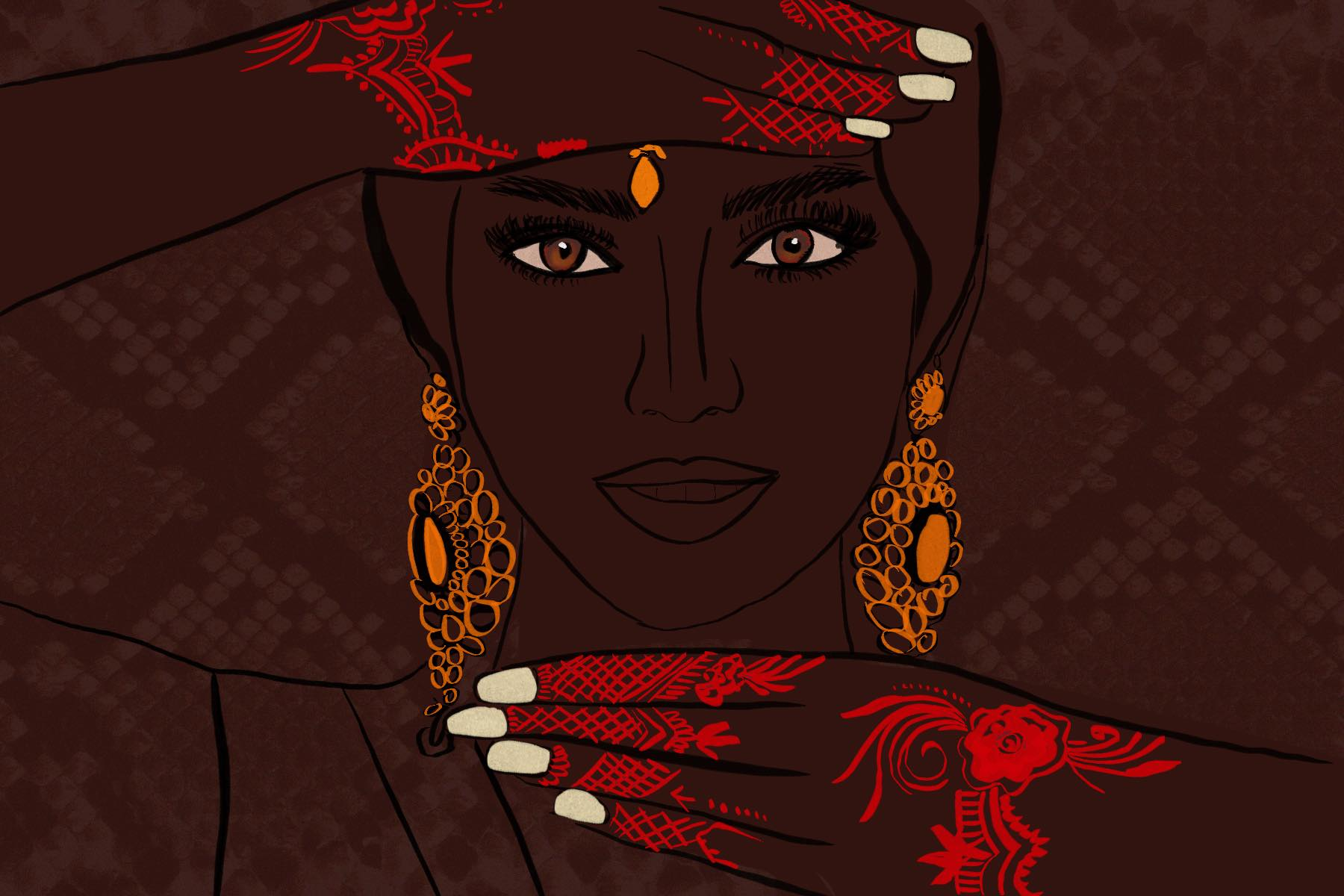
Ecdysis
by Jaimini Patel | June 7, 2020
She starts off in vibrant red, the same colour as chandlos on the brown foreheads of Indian women. The scene changes. Countless embroidered mirrors glint on the folds of her lehenga, the sky-blue skirt flowing down from her brown midriff. Cue another scene change. She emerges in a yellow salwar kameez, everything covered except her brown neckline which glistens in the moonlight. The colours whirl and merge as one scene changes to another, a kaleidoscopic mix on the ever-present brown tones of her skin. The woman is Rani Mukherjee: an icon of the Bollywood screen. For me, as a little girl, she epitomised beauty.
There’s an irony to the fact that on the same screen where I found my brown-skinned role model, Clean and Dry Intimate Wash broadcasts its advertisements to millions of dark-skinned women. Want to whiten your vagina? Look no further. Clean and Dry has your solution. This particular Clean and Dry advertisement provoked outrage, but the problem extends far deeper than one advertisement. On Shaadi.com, a website for Indian marriages, whiteness is a key determinant of a bride’s value. No wonder Fair and Lovely skin cream takes the prize for the largest share of the Indian cosmetics market. Whiteness is the gold standard in beauty.
Indeed, this is just how Naomi Wolf has actually labelled beauty: “a currency system like the gold standard. Like any economy it is determined by politics.” Unfortunately, however, the goods valued in this case are human beings, and the politics that determines their worth consists of a complex mix of historical injustices to do with the superiority of light skin. Wolf argues that beauty is like a currency in the sense that it gives us a value, which we can increase by buying further into mainstream beauty standards. Standards in India are rooted in being fair-skinned, and they will continue to hold back women despite other progress, ingraining in women the idea that they can only succeed if they whiten their skin. Sadly, it seems to be working – as evidenced by the fact that 90% of women in India cite skin-lightening as a high-need area. After all, light skin facilitates success not only in the job market, where dark-skinned girls are often rejected for jobs like stewardesses due to their appearance, but also in the marriage market where bride advertisements often specify that the woman is fair-skinned and so more desirable.
Whilst many Indian women struggle against dichotomous beauty standards (white good, dark bad), I personally felt these racist beauty standards were a world away for most of my childhood. My mother would tell me that beauty is in the eye of the beholder, and I believed her. However, as I grew up a thought nagged at my subconscious: whilst all girls may be beautiful, some seem to be more beautiful than others. I attended an extremely diverse school in Dubai – yet the girls deemed the prettiest all had white skin. Things came to a head in sixth form, when posters were put up anonymously calling out some of the remarks made by boys of my peer group. “I would never pull a brown girl,” my eyes scanned over. “Ew, if your girlfriend is brown, does that mean she has dark nipples.” There I had my proof, written in unmistakable letters. Beauty was far from the eye of the beholder. Beauty was scrutinised by the eye of society, a society plagued by a neo-colonial discourse.
One need look no further than the works of British colonialist Rudyard Kipling to understand one of the places where the link between whiteness and beauty stems from. The British empire was expanding rapidly at the end of the 19th century to cover one quarter of the Earth, and Kipling was front and centre of the imperial propaganda machine through his literature. A key ideological tenet of empire was rooted in Social Darwinism: the idea that certain groups of society are innately born more powerful than others. For Kipling and other imperialists, this innately powerful group was embodied in the white coloniser – people of colour were conceptualised as beasts, a more primitive form of being, whose life would be all the better via colonial domination.
It is perhaps no surprise then that a key image in the British colonial discourse is that of white colonisers bringing light to dark Indian savages. Indeed, in his infamous poem ‘The White Man’s Burden’, Kipling encourages white colonialists to “Send forth the best ye breed” so that colonisers can tame “Your new-caught sullen peoples/Half devil and half child”. It is rhetoric like this that shows how prejudice against dark skin is rooted in the imperial discourse. Whiteness is associated with the purity and justice of heaven whereas darkness is quite literally conceptualised as a product of hell, representative of sin and ugliness: to be white-skinned is to be moral. Dark-skinned people are a sub-human sort of race: “half devil”, as Kipling puts it, and they must be tamed by their superior white skinned counterparts. These racist phenomena were not a mere figment of colonial discourse, they translated into the day-to-day life of the British Raj. Entry to restaurants and educational institutions was barred not to all Indians, but to ‘Black Indians’. Light-skinned Indians were given posts higher up in the army whereas dark-skinned Indians filled the most menial jobs, if any at all.
In a society where the very name of Rhodes Scholar incites protest, such rhetoric and discrimination are surely things of the past. Yet as I turn my TV on and see the glaring whiteness of the Fair and Lovely advertisements broadcasting to millions of Indian women, I get a glimpse of what it feels like to be the dark-skinned other. Colonial poetry may have been propaganda of the past, but today’s white beauty standards are still rooted in the core of the British Raj. The medium may have changed from poetry to TV advertisements, but the message has not. Behold thousands of Indian women bleaching their skin, shedding its melanin and cultural depth like an animal hide, in a desperate bid to be white: the ultimate symbol of social standing, culture, and even moral righteousness.
Such religious overtones reveal an even deeper-rooted prejudice: working hand in hand with the colonial system to glorify white skin is the caste system. This is a hierarchy espoused by one of Hinduism’s oldest sacred texts, which divides society into four levels (or castes). At the top of the system are a group known as Brahmins, going all the way down to the lowest social strata, a sub-caste of sorts known as the Dalits, or the ‘untouchables’. The Dalits have traditionally been conceptualised as like the feet of a body – more in touch with our bestial nature than our rational human capacities which are found in the head. To understand how the caste system relates to skin colour, it is useful to refer to another of Kipling’s pieces, a short story titled ‘Beyond the Pale’. It tells the tale of a European man who falls in love with an Indian woman, and both characters pay the consequences – the woman’s hands are cut off by her father in anger, and the man is struck in the groin by knife stroke.
This disturbing short story starts with a moral claimed to be a Hindu proverb: “A man should, whatever happens, keep to his own caste, race and breed. Let the White go to the White and the Black to the Black.” Kipling’s story is a tragedy and its inevitable ending is indicated from the outset by this proverb: any inter-racial relationship is doomed to end horrifically. Whilst Kipling may have written this story against a backdrop of Social Darwinism, thinking it is perhaps unnatural for superior white men to liaise with inferior dark-skinned women, it reveals that the root of the problem extends deeper as such ideals start from a Hindu proverb (independent of the British empire). Such Hindu ideals are of course not the determining factor of social class in modern Indian society: they really only applied in the Vedic period (1500BCE to 500BCE).
However, much like how we still see the influence of Classical culture in the Western world, Vedic culture still has a certain hold on modern Indian society. Tannishtha Chaterjee, an Indian actress, was subjected to caste-based prejudice whilst promoting a movie on a comedy TV programme. “You must like black plums. How many have you eaten since childhood?” one presenter mocked. Having faced a number of such taunts, Chaterjee ended up having to leave the programme, protesting afterwards that “most of us will not admit our hatred for dark skin also comes from caste bias.” These jibes were more than harmless taunts and have an ominous background. Dark skin has long been associated with the ‘untouchable’ caste, as it was this class who laboured outdoors for generations like mere beasts of burden, exposed to the sun far more than privileged castes. Fairer skin is thus an asset of the Brahmin class at the top of society, and so people naturally incline towards fair skin in their search for standing, societal acceptance, and wealth.
Whilst the caste system and colonialism are problems rooted in history, modern society provides the perfect tool to solidify these twin evils: globalisation. Western multinational companies have an insidious hold on the Indian beauty market, capitalising on the idea that whiteness is beauty. L’Oreal sales in India are booming as the brand pledges to increase the luminosity of brown skin, whilst Ponds advertisements in India show a dark-skinned lover winning her man back by applying their whitening cream. It is not only women who are prey to this beast – Vaseline recently launched a Facebook app for men which lightens their skin on profile pictures, snapping up Bollywood star Shahid Kapoor to launch this latest creation. In the context of a globalised world saturated with whitening skin products from all ends of the earth, white beauty is more than a standard – it is a commodity, and one that is growing in sales at an alarming rate. When Naomi Wolf conceptualised beauty as a currency system like the gold standard, her point was that we needed to dispel this myth that beauty could be conceptualised homogeneously: the very title of her book was The Beauty Myth. However, in the context of a globalised market, white beauty standards as a currency system cannot be further from mythical: they are deeply rooted in the economic and social reality of Indian society.
A common historical metaphor applied to dark-skinned people was that of the beast. Imperial Social Darwinism conceptualised black Indians as a bestial race needing to be civilised, and the caste system predating empire created a class of dark-skinned labourers treated no better than beasts of burden. Today, with the advent of whitening products, it seems that the metaphor of the beast has metamorphosed into that of a snake. Ecdysis is the process wherein a snake sheds its old skin for new, ridding itself of parasites and over-stretched tissue that no longer serves its purpose well. As I watch countless dark-skinned people undergo constant bleaching processes, the promises of the latest all-in-one whitening, illuminating, anti-aging and clarifying cream moving from the sublime to the ridiculous, I cannot help but compare the two situations. Just as the snake rids itself of worthless skin, so human beings are trying to shed their darker tones for lighter ones – dark tones that have long been associated with a sense of inferiority that extends far beyond skin-deep. However, whilst the snake seeks replenished skin that will serve it well in the wild, human beings seek skin that will serve to provide social acceptance.
If we are to move forward, we need to realise that it is not only darker tones that are being shed, but cultural heritage and diversity. India’s beauty lies in the conglomeration of different racial groups, religions, and appearances that characterise her different regions – and with these differences comes a spectrum of different skin colours. We cannot choose which colour we are born, but we can choose how we engage with our appearance. Before preaching about how beauty is more than just skin-deep, let’s embrace the beauty that is already present in dark skin. Kipling may have sung of the ‘white man’s burden’, but it seems to be the brown woman who has borne the crippling brunt of that burden: the weight of ingrained beauty standards that should long have been condemned to the past.∎
Words by Jaimini Patel. Art by Sasha LaCômbe.




